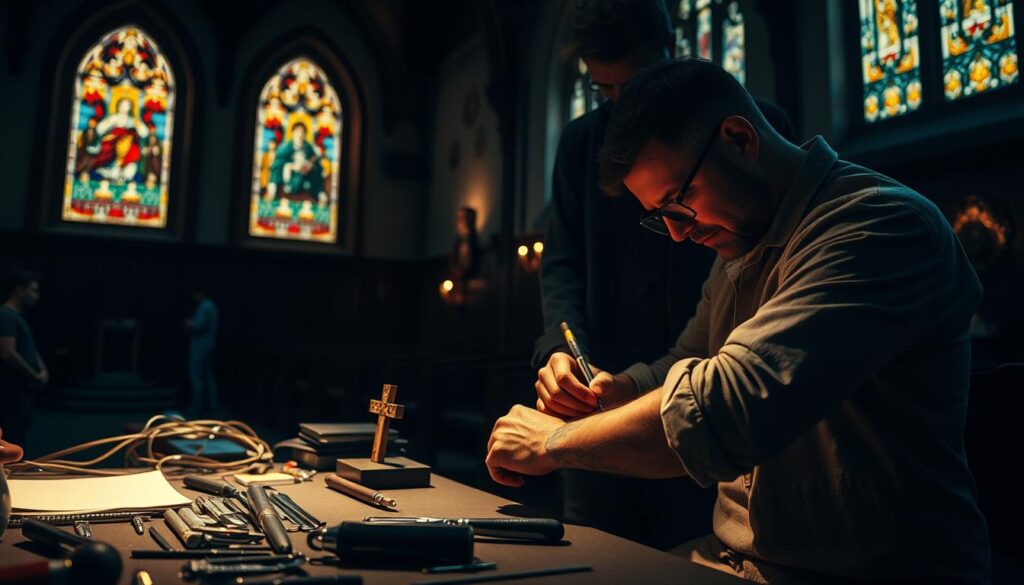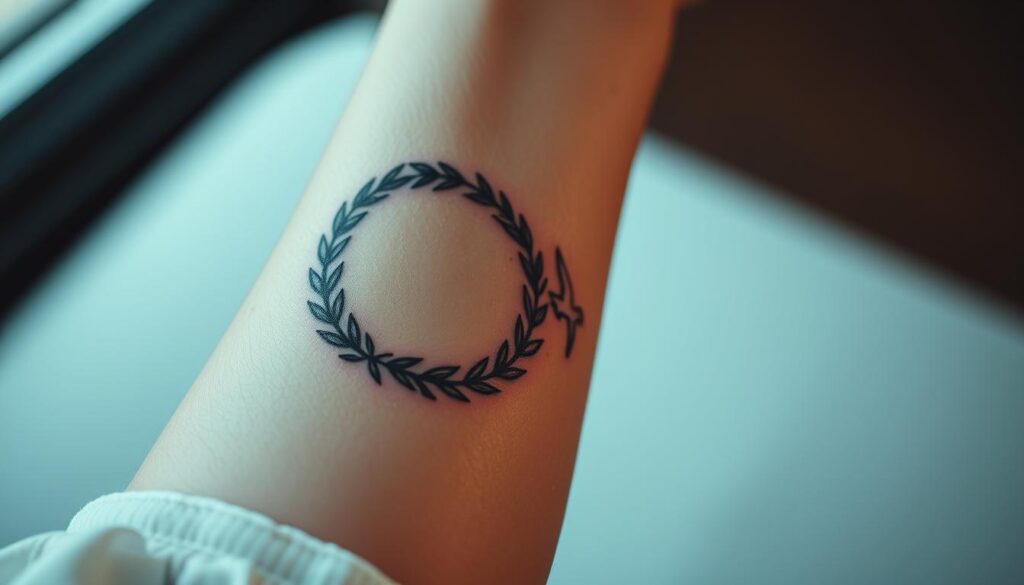
What if a centuries-old tradition inside the Christian faith challenges everything you’ve been taught about body art? For over 700 years, the Razzouk family has inked religious symbols on pilgrims in Jerusalem’s Christian Quarter – a practice that continues today. This paradox reveals a deeper tension between ancient scripture and modern faith expressions.
Many believers grew up hearing Leviticus 19:28’s warning against marking the skin. Yet the same sacred texts guided generations of faithful who wore permanent reminders of their spiritual journey. How do we reconcile these seemingly conflicting views in today’s world?
The answer isn’t found in quick judgments but through thoughtful exploration. Ancient Israel’s cultural context matters – their laws addressed specific idolatrous practices, not modern self-expression. As you’ll discover, New Testament principles shift the focus from external rules to heart motivations.
Key Takeaways
- The world’s oldest operating tattoo shop specializes in Christian symbols and serves pilgrims in Jerusalem
- Biblical references to body markings were tied to specific cultural practices of the ancient Near East
- Modern faith practices require understanding both scripture’s original intent and contemporary applications
- Personal conviction and cultural witness play crucial roles in faith-based decisions about body art
- Church history contains surprising examples of religious tattooing traditions
This exploration goes beyond simple yes/no answers. You’ll examine historical evidence, analyze scriptural context, and consider how your choices reflect Christ’s love. Ready to see this heated debate through fresh eyes?
Biblical Foundations: Old and New Testament Perspectives

Navigating Scripture’s teachings requires understanding their original setting. Ancient Near Eastern cultures used body modifications differently than modern societies – often as spiritual markers rather than personal expression.
Leviticus 19:28 and the Context of Ancient Law
The Old Testament prohibition against marking skin appears alongside rules about harvest practices and garment materials. Scholars note the Hebrew term “kethobeth” might describe temporary ritual markings, not permanent tattoos. This command specifically addressed Canaanite mourning rites that involved cutting flesh for pagan deities.
“Do not think I have come to abolish the Law… but to fulfill them.”
Jesus’ Fulfillment of the Law and New Covenant Insights
Christ’s sacrifice reshaped how believers relate to law codes. Temple-based rituals became unnecessary after 70 A.D., shifting focus to internal transformation. Paul emphasizes in Romans that love fulfills law requirements more than strict rule-keeping.
| Old Testament Perspective | New Covenant Approach |
|---|---|
| Physical purity rituals | Heart-centered obedience |
| Temple sacrifices | Christ’s ultimate sacrifice |
| External prohibitions | Motivation examination |
Modern debates mirror early church discussions about Gentile converts keeping Jewish customs. Your personal convictions should balance scriptural wisdom with cultural sensitivity – neither dismissing Old Testament principles nor ignoring Christ’s transformative work.
Historical and Cultural Insights into Christian Tattooing

Faith communities have used body art for spiritual expression longer than most realize. The Razzouk family’s Jerusalem shop holds wooden stamps carved with crosses and saints – tools unchanged since their ancestors inked Coptic pilgrims in 14th-century Egypt.
Ink as Inheritance: A 700-Year Tradition
Twenty-eight generations of Razzouks have marked believers’ skin with sacred symbols. Their needlework tells stories: Crusader crosses, Marian icons, and Christ’s crown mingle with pilgrims’ personal prayers. This living museum challenges assumptions about religious adornment.
Some scholars suggest Revelation’s description of Jesus’ thigh inscription (“King of kings”) hints at divine approval of meaningful markings. While speculative, this perspective reframes ancient texts through historical practices.
Body Art Bridges Cultural Gaps
Modern faith expressions adapt to shifting norms. Where tattoos once signaled rebellion, many now serve as conversation starters about spiritual journeys. A biker’s sleeve ink might open doors closed by traditional clothing or speech.
Consider these contrasts:
| Historical Practice | Modern Application |
|---|---|
| Pilgrimage markers | Personal testimony tools |
| Community rituals | Individual expression |
| Cultural uniformity | Diverse artistic styles |
Your jewelry choices or hairstyle decisions follow similar logic – outward signs reflecting inner values. As stigma fades, more believers find creative ways to wear their faith literally on their sleeves.
can christians get tattoos: Weighing Biblical Teachings and Practical Considerations

How do ancient principles guide modern decisions about personal adornment? Paul’s words in 1 Corinthians 10:23 offer a compass: “Everything is permissible – but not everything builds up.” This tension between freedom and wisdom shapes every faith-driven choice.
Scripture Meets Skin: Ancient Truth in Modern Ink
Your desire for body art isn’t intrinsically evil, but motives matter. Are you seeking to bear spiritual fruit or follow fleeting trends? The Old Testament prohibition addressed specific pagan rituals – not today’s artistic expressions. Yet Paul’s warning about causing others to stumble remains vital.
“Let no one seek his own good, but the good of his neighbor.”
Practical Faith in Permanent Ink
Consider these factors before deciding:
| Spiritual Factors | Practical Concerns |
|---|---|
| Alignment with godly joy | Cost versus stewardship |
| Potential ministry impact | Professional implications |
| Community witness | Design appropriateness |
James 1:5 reminds us to seek divine wisdom. Could your adornment become a bridge for good works? Or might it distract from your testimony? Discuss designs with mature believers – their perspective might reveal blind spots.
Financial stewardship plays a role too. Premium tattoos often cost thousands. Would those funds better serve others? Your choice becomes worship when made prayerfully, balancing personal joy with love for neighbors.
Conclusion
Your faith journey deserves thoughtful reflection when considering permanent adornment. While Scripture doesn’t explicitly forbid body art, it challenges us to examine how our choices bear spiritual fruit. The law in Leviticus addressed specific cultural practices – not modern expressions of devotion.
History shows surprising flexibility. For centuries, believers have marked their skin with sacred symbols as acts of worship. Yet Paul’s wisdom remains vital: “Everything is permissible, but not everything builds up.” Your decision should flow from prayerful discernment rather than cultural pressure.
Consider two key questions: Does this choice honor God’s design for your body? Will it enhance your ability to love others well? Many Christians find tattoos become meaningful conversation starters about their spiritual lives. Others maintain a different view out of respect for tradition.
Ultimately, your worth rests in Christ’s redeeming work – not what marks your skin. Whether choosing ink or abstaining, let love guide your actions. The difference lies not in appearances, but in a heart surrendered to divine purpose.
